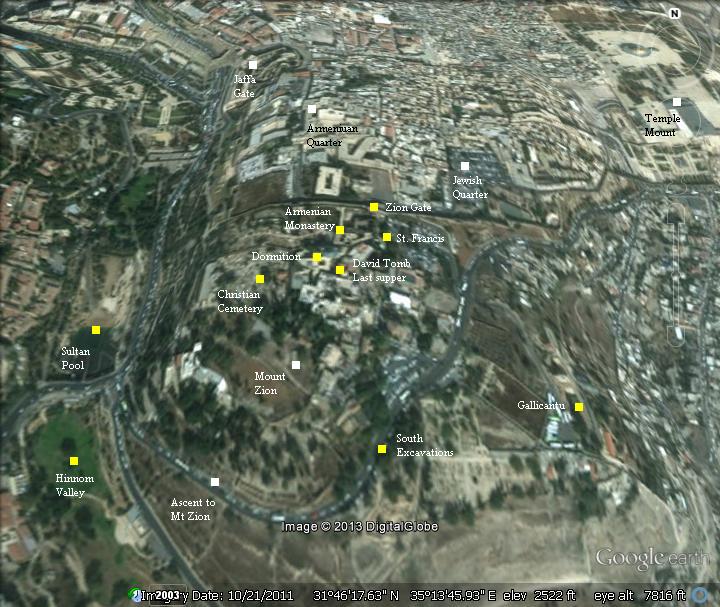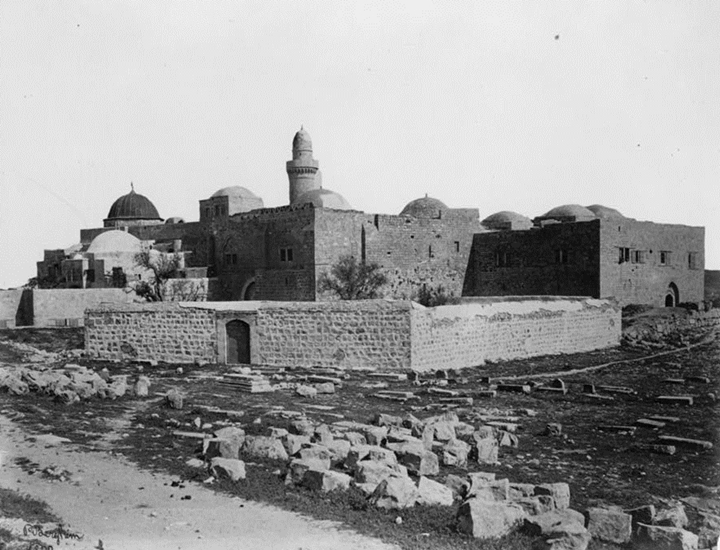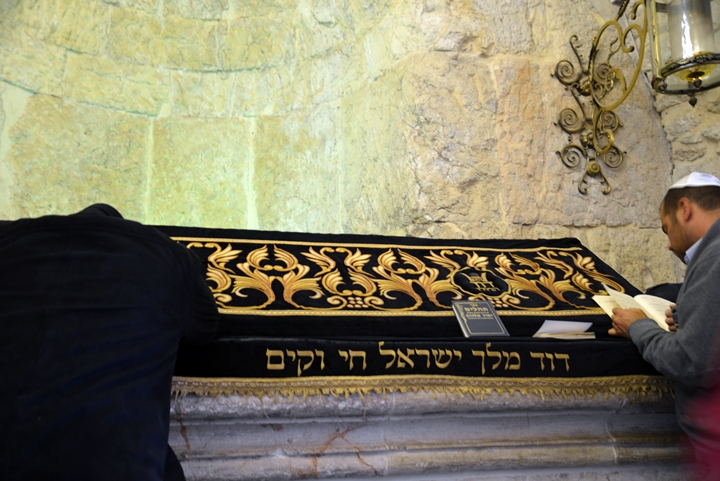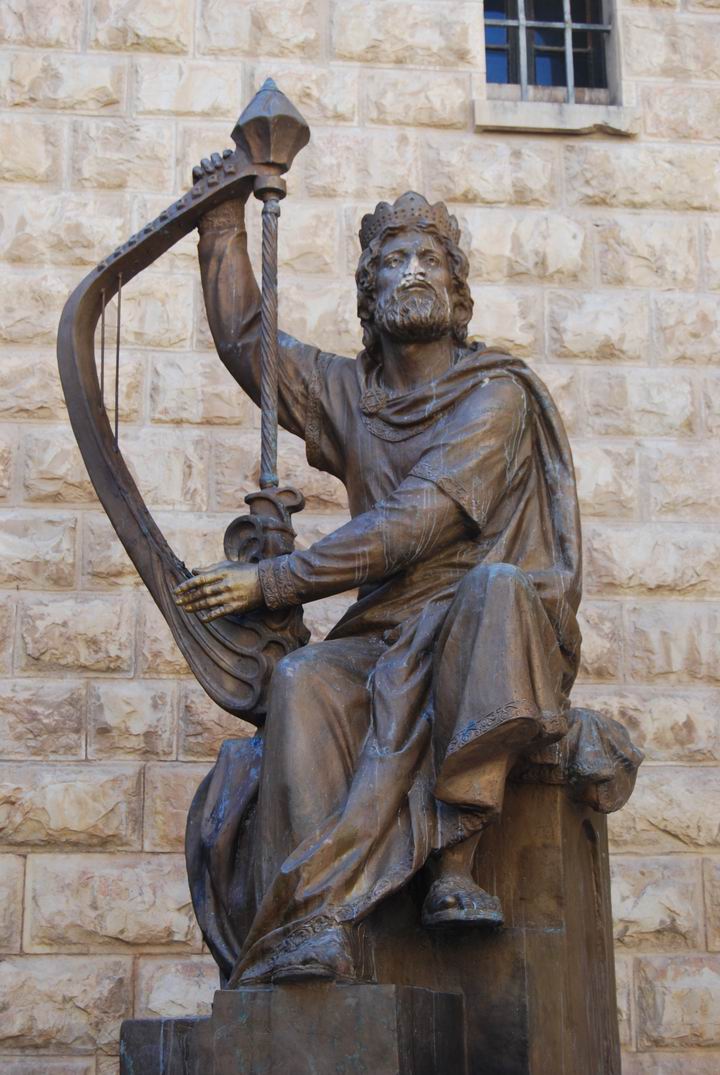The site, located on Mount Zion, is the traditional site of the tomb of King David, and one of the most holiest places for Jews, Christians and Muslims. It is one of the few sites in the world that is shared by the 3 religions.
Home > Sites > Jerusalem > Mount Zion > King David’s tomb
Contents:
Overview
Location
History
Photos
* Entrance
* First floor
* Second floor
* Third floor
Biblical references
Links
Overview:
The Tomb of King David is a revered site for Jews, located on Mount Zion in Jerusalem. It is believed to be the burial place of King David, the second king of Israel, who is credited with uniting the tribes of Israel and establishing Jerusalem as its capital. The Bible wrote about David’s resting place: 1 Kings 2: 10: “So David slept with his fathers, and was buried in the city of David”.
The tomb is located in a room that is traditionally believed to have been David’s palace, and is accessed by a set of stairs. The tomb itself is covered in a velvet cloth and is surrounded by a metal fence. The room is also used for prayer and study by Orthodox Jewish men.
While the authenticity of the tomb is a matter of debate among scholars, the site has been an important pilgrimage site for Jews for centuries. It has also been the site of numerous conflicts between Jewish and Muslim communities in Jerusalem.
On the ground level are several Jewish synagogues, and the site is one of the most Holiest Jewish places. The second level is a holy place for Christians – the location of the “last supper“, which is detailed in another page. The third level has a Muslim muezzin tower.
Location:
The site is located on Mount Zion, outside of the old city walls and 100M south-west to Zion gate. It is easily accessed from the parking lot near the Zion gate, through an alley that passes the Dormition abbey on the left side.

History :
- Biblical periods – City of David
King David was buried at about 1000BC, probably in the area south of the present walled city, where the “city of David” was located. This is what the Bible tells us (1 Kings 2: 10):
“So David slept with his fathers, and was buried in the city of David”.
Other Kings from the house of David were buried there too, as implied in Nehemiah 3, 16: “…the sepulchres of David…”.
After several centuries the tombs were probably destroyed and buried under the newly expanding city. This may have happened during the 1st or 2nd century AD.
- Roman period – Mount Zion
Mount Zion was not part of the city of David, and is located several hundred meters away to the north-west. The hill was incorporated into the new city only in the Hellenistic and early Roman periods – within the new walls of the “upper” city.
An archaeological survey was conducted in 1948 after the building suffered from damages during the Independence war. According to the survey, the Roman level (end of 1st century AD) was the “ground” level of the present structure. On top of it there were several layers of construction. Based on the findings, the original building may have been an early synagogue, which was built after the destruction of the temple. Another survey was conducted in 2011, identifying 6 archaeological layers, with the earliest findings was a wall (‘W4’), possibly a synagogue of the the Roman period.
- New testament
St. Peter and the other apostles talk about David’s tomb in Acts 2 29:
“…the patriarch David, that he is both dead and buried, and his sepulchre is with us unto this day.”
This text may relate to the original site of the tombs of the house of David, or the new location on Mount Zion.
- Byzantine period
Several hundred years later, during the Byzantine period, the early Christians built several churches around Mount Zion. The archaeological survey identified the second level in this site, above the early Roman level, was a Byzantine building.
- Persian and Arab conquest
After the Arab conquest, the area remained in ruins from the 7th century until the 12th century.
The tradition of the location of King David’s tomb on Mount Zion was first documented at this time (9th century).
- Crusaders
The Crusaders rebuilt some of the structures on Mount Zion, as well as many sections of Jerusalem. The archaeologists found a level from that period (12-13th century), above the Byzantine level and below the present floor.
After the Crusaders retreated the structured was cared by Monks for some time.
- Ottomans
The Ottomans did not include the area inside the 16th century wall, but regarded the site as a Holy place – the site of the King David’s tomb. They banished the monks, and transformed it into a mosque, E-Nebi Daud, or: the prophet David. In the building around the site lived a Muslim family, who held the keys to the site.
In 1864 an archaeological excavation revealed a shallow cave (35M x 15M x 4M) under the ground level.
A photo of the structure from the Ottoman years is below.

Photos of the LOC, Photographer: Bergheim, P. 1860-1880
- Modern times
The Jews and Christians were banned for hundreds of years to freely visit the site. This changed in 1948 when the Independent Israel received control over the Holy site, and after the city was reunited in 1967 the site became one of the major Religious sites in the Holy Land, cherished by the three religions.
Photos:
The entrance to the complex of King David’s traditional tomb and the place of the Last supper is seen below – on the left side, where the synagogues are located on the lower level, the Christian site is on the second level, and the Muslim on the roof. The wall on the right is part of the Dormition abbey.
Click on the photos to view in higher resolution…
(a) First floor: Jewish
The entrance to the complex is seen below.
An inner court yard, facing the south east, is is seen below. There is a Yeshiva located in that section.
Another view of that court yard, from the ground level.
The Tomb is located in a corner of a room on the ground level. The stone sarcophagus is covered by a cloth, with the words: “David King of Israel is Alive and Enduring”.
(b) Second floor: Christian
The second floor is the traditional site of the “Last Supper”. See more details in a separate page.
(c) Third floor: Muslim
On the roof, above the “Last supper” hall, is a balcony that is seen below. The closest tower is a Muslim muezzin call-for-pray tower, part of the Muslim mosque. Behind it, on the background, is the bell tower of the Dormition abbey.
From this place is a nice panorama of Jerusalem. A small room on the roof used to be a resting place for Israel’s 2nd president, Izaac Ben Zvi. It was before Jerusalem was reunited in 1967 with east Jerusalem, when the balcony was on the border and the only spot where the temple mount could be seen from the Israeli side.
Biblical References:
(a) 1 Kings 2:10:
This text tells us where David was buried – in the city of David.
“So David slept with his fathers, and was buried in the city of David“.
(b) Nehemiah 3: 16:
Nehemiah was one of the leaders of the exiles that returned back to Zion at about 500BC. The text tells about a cluster of tombs , where Kings of the house of David were buried:
“…unto the place over against the sepulchres of David, and to the pool that was made, and unto the house of the mighty”.
(c) Acts 2:29
The Tomb of David is referred in the new Testament, by Peter:
“Men and brethren, let me freely speak unto you of the patriarch David, that he is both dead and buried, and his sepulchre is with us unto this day”.
A sculpture of King David playing the Harp is located near the entrance to the site. Check the “King David’s harp” bridge for the Biblical reference on David and the harp.
Links:
* External links:
* BibleWalks pages:
BibleWalks.com – walk with us through the sites of the Holy Land
Dormition <—previous Jerusalem site–<<< All Sites >>>—> Last Supper
![]()
This page was last updated on Mar 19, 2023 (new overview)
Sponsored links:

